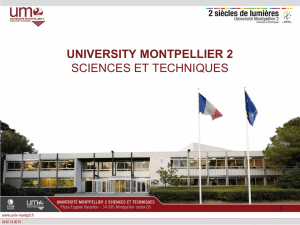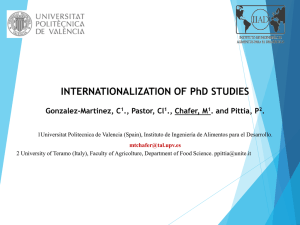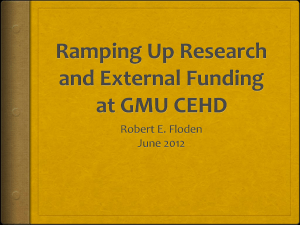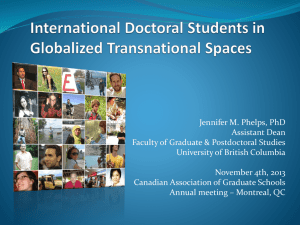Doctoral Enrolments and Graduation in South Africa
advertisement
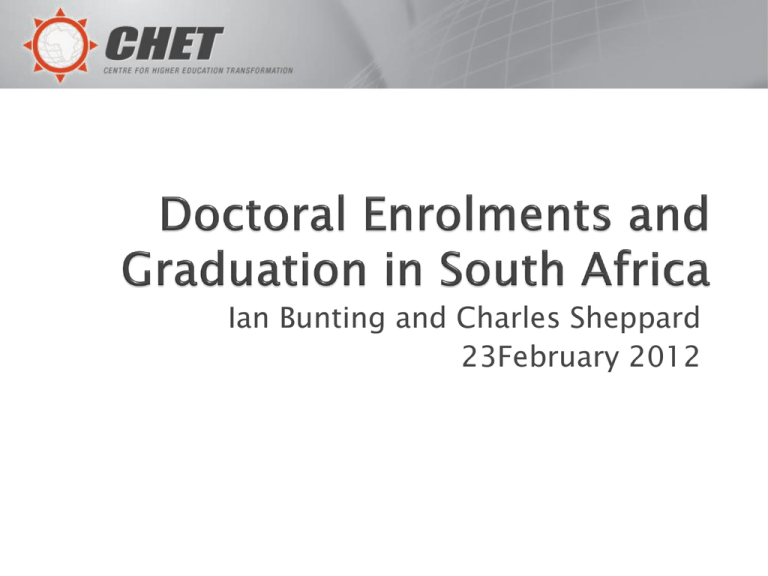
Ian Bunting and Charles Sheppard 23February 2012 Graph 1: Doctoral enrolments, doctoral graduates and research publications Graph 2: Average annual changes: enrolments, graduates and publications Graph 3: Doctoral enrolments by race group Graph 4: Percentage of doctoral enrolments in race groupings Graph 5: Graduation rates and cohort output equivalents Graph 6: Actual doctoral graduates vs normative totals on National Plan target ratio Graph 7: Permanent academic staff Graph 8: Percentage of academic staff with doctorates by institutional category Graph 9: Ratios of doctoral enrolments to academic staff with doctorates Graph 10: Government research funding allocations by output category & financial year Graph 11: Estimates of Rand values of research outputs Graph 12: Average annual increases in outputs Graph 13: Total government research output funding per permanent academic Graph 14: Doctoral and publication output funding per permanent academic (2011/12) 2 Graph 1 sets out data on key elements of SA’s high-level knowledge production for the period 1996-2010 expressed as doctoral enrolments, doctoral graduates and research publication units. Average annual changes in these totals are reflected in Graph 2. 14000 11468 12000 9 800 1 0000 8790 4 000 2 000 Research pubs 7763 8 000 6 000 PhD enrolments 9939 5 622 5528 9 748 6 394 8 003 6483 6660 8 353 5 164 5456 5 936 6 85 761 961 9 69 1 104 1100 1 182 1 421 1996 1998 2000 2 002 2004 2006 2 008 2010 PhD graduates 0 Doctoral enrolments Doctoral graduates R esearch publications 3 Graph 2 divides Graph 1 growth rates into the period between (a) 1996 and 2002, which covered the period of the 1997 HE White Paper and the 2001 National Plans, and (b) 2004-2010 which covered the introduction and implementation of the new 2003 government funding framework. 8.0% 7.0% 6.0% 7.0% 6.6% 6 .0% 5.9% 5 .4% 5.0% 4.5% 4 .3% 4.0% 4.0% 3.0% 2.4% 2.0% 1 .0% 0 .0% 1996-2002 Doctoral enrolments 2004-2010 Doctoral graduates 1996-2010 R esearch publications 4 Graph 3 divides the doctoral enrolment totals for 1996-2010 into race groupings. The main change has been in African doctoral enrolments, which increased from 663 in 1996 to 5066 in 2010, when African doctoral enrolments exceeded that of White enrolments for the first time. 6000 4861 5 000 4486 4 020 4000 3 875 4819 3993 3583 5066 African White 4 853 4 568 4 022 2 933 3 000 2239 2000 1610 1 053 1000 0 683 197 264 1996 344 256 1998 African 464 3 27 2000 7 68 8 13 774 8 68 419 5 29 585 575 6 81 2 002 2004 2006 2 008 2010 6 19 Coloured Indian White Indian Coloured 5 Graph 4 shows how the % of doctoral enrolments by race group changed between 1996 to 2010. African doctoral students rose from 13% in 1996 to 33% in 2004, and 44% in 2010. 9 0% 8 0% 78% 7 0% 62% 55% 6 0% 49% 5 0% 41% 4 0% 33% 13% 13% 12% 10% 2004 2 008 1 0% 0% 42% African White 25% 3 0% 2 0% 44% 14% Coloured+Indian 9% 1996 2 000 African White Coloured +Indian 2010 6 Graph 5 offers a first picture of the doctoral output efficiency of SA’s public HE system, based on output ratios which appear in the 2001 National Plan. The National Plan set this as an output norm: • • The ratio between doctoral graduates in a given year and doctoral enrolments should = 20%. So, if 10 000 doctoral students were enrolled in the HE system in year X, then at least 200 of these students should graduate in year X. This norm was based on a further target norm that at least 75% of any cohort of students entering doctoral studies for the first time in (say) year Y, should eventually graduate. Calculations had shown that if the cohort output norm was to be achieved, then the 20% ratio of total graduates to total enrolments would have to be met over a period of time. 7 Graph 5 shows that, as far as doctoral outputs are concerned, the Public HE system has failed to meet the National Plan’s efficiency targets. Calculations show that over the period 1996–2002, less than 50% of students entering doctoral programmes in SA will eventually graduate. 8 0% 75% 7 0% 6 0% 52% 5 0% 45% 45% 4 0% 3 0% 2 0% 20% 14% 12% 12% 1998-2002 2 002-2006 2006-2008 1 0% 0% R atio of graduates to enrolments Cohort graduation equivalent National target 8 Graph 6 offers estimates of the effects of inefficiencies in SA’s doctoral programmes. For example, over the period 2005-2010, SA should, on the National Plan’s norms, have produced a total of 12 285 doctoral graduates but in fact produced only 7 711, leaving a “shortfall” of 4 739 graduates (who would have been drop outs from the system). 2005 - 2010 -4 739 Shortfall -2735 2000 - 2004 2005 - 2010 National Plan target 2000 - 2004 2005 - 2010 Actual graduates produced -6000 -4000 -2000 2000 - 2004 0 2000 4000 T otal 2005-2010 12285 7 711 7 546 4976 6000 8000 T otal 2000-2004 10000 12000 14000 9 Academic staff with doctoral degrees are a key input for high-level knowledge production is. Permanent academic staff in this category should be the major producers of research outputs, and at an input level the main supervisors of doctoral students. Graph 7 shows how the totals of permanent academic staff with doctoral degrees changed between 1996 and 2010. 18000 16000 1 4000 1 3449 13098 4647 4658 14184 14673 15423 1 5809 15936 5 146 5403 1 6684 T otal permanent 12000 10000 8 000 6 000 4561 4572 4485 5957 Highest qualification PhD 4 000 2 000 0 1 996 1998 2000 2002 Doctorate as highest qualification 2004 2 006 2008 Total permanent 2010 10 Graph 8 divides public HE institutions into the 3 categories used for national planning purposes, and sub-divides the 11 universities into a group of 6 which produces 60% of the HE system’s total high-level knowledge products and the remaining 5. The groups are: High productive universities UCT, UKZN, Pretoria, Rhodes, Stellenbosch, Wits Other universities Fort Hare, Free State, Limpopo, North West, UWC Comprehensive universities UJ, NMMU, Unisa, Venda, WSU, Zululand Universities of technology Cape Peninsula, Central, Durban, Mangosuthu, Tshwane, Vaal DUT 11 Graph 8 60% 50% 40% 45% 36% 48% 41% 29% 2 0% 5% Other 35% 38% 28% 29% High productive 44% 40% 36% 30% 10% 44% 27% 7% 8% 2002 2 004 28% 10% 29% 40% Comprehensive 28% 13% 15% 2008 2010 UoT 0% 2000 High productive universities Other universities 2 006 Comprehenives Universities of technology 12 The low proportions permanent academic staff with doctoral degrees must have an impact on the numbers of doctoral students which can be enrolled and supervised. Graph 9 shows what the ratios have been between doctoral enrolments and permanent academic staff with doctorates. A ratio of two doctoral enrolments per permanent academic with a doctorate could be used as an indicator of institutional capacity. Graph 9 shows that the high productive group of universities and the comprehensives had ratios above 2 in 2010, which could be taken to imply that they have reached capacity as far as doctoral enrolments are concerned. Increases in their doctoral enrolments should depend on more academic staff obtain their own doctoral degrees. The 2:1 norm suggests that the other group of 5 universities and the universities of technology may have spare supervisory capacity, but their ability to deal with this depends on their current financial and efficiency levels. 13 Graph 9 2 .5 2 .2 2 .0 1 .7 2 .1 1 .8 1 .5 2.1 1.7 1.7 2.1 2.1 Other 1.7 1 .2 1.0 0.5 1.1 1 .2 High productive Comprehensive UoT 1.1 1.2 0 .8 0.0 2 000 High productive universities 2 004 Other universities 2 008 Comprehenives 2 010 Universities of technology 14 Government’s funding incentives for research outputs are complex because of the 2-year time lag between the completing of an output and the receipt of a funding allocation, and the weightings applied to research outputs. Graph 10 shows what research funding totals were generated by each output category. Graph 11 shows what the Rand values can be assigned to research output units. 15 Graph 10 R 'millions 2500 2225 2000 Total 1837 1540 1500 1000 500 845 474 192 0 1245 1237 179 2004/05 919 489 228 202 2005/06 Publications units 1225 505 265 Pub. units 1 048 1024 652 596 310 343 253 298 282 2006/07 2007/08 2008/09 Research masters grads 796 379 4 14 365 375 2009/10 2010/11 Doctoral graduates 539 461 PhD graduates Research M grads 2011/12 Total 16 Graph 11 R'000 450 393 400 Per PhD graduate 3 50 2 86 3 00 251 250 200 191 150 1 00 50 87 66 91 82 110 1 02 1 10 134 Per publication unit Per research M grads 0 2005/06 Per publication unit 2007/08 2009/10 Per research masters graduate 2 011/12 Per doctoral graduate 17 It could be argued that the high Rand values for doctoral graduates should have functioned as strong incentives to institutions to expand these outputs. The data in Graph 12 suggest these financial incentives have not yet affected doctoral graduate growth, which was 3.5% pa between 2000 & 2004, and 3.6% pa between 2005 and 2010. There are likely to be a number of reasons why doctoral graduate totals have not yet responded to the output funding incentives introduced for the first time in the 2004/5 financial year. One explanation is that only a few universities have been able to benefit from the introduction of government research output incentives. A second explanation is that doctoral processes in SA have been characterised by high levels of inefficiency, as has been seen in Graphs 5 and 6. 18 Graph 12 6.7% 7.0% 6 .2% 5.8% 6.0% 5.0% 4.4% 4.4% 4 .0% 3.5% 3.6% 3 .0% 2.0% 1.5% 1.0% 0.0% Publication units Masters graduates: Research masters coursework + research graduates 2 000-2004 Doctoral graduates 2 005-2010 19 Graph 13 shows that government output funding can be related to staff capacity. In 2011/12 the high productive university group generated R290 000 in government research funds per permanent academic, which was considerably higher than the averages for the other groupings. R'000 350 290 3 00 High productive 250 2 15 192 200 1 50 135 58 0 Other 94 100 50 130 39 68 46 60 66 Comprehensive 8 13 19 25 2 005/06 2 007/08 2 009/10 2 011/12 High productive universities Other universities Comprehenives UoT Universities of technology 20 Graph 14 relates doctoral graduate funding to permanent academic staff, but also compares this doctoral funding to research publication funding per permanent academic. The graph shows that in 2011/12 the high productive universities group generated R82 000 in doctoral funding per permanent academic, and R126 000 in research publications. The amounts are lower, but similar wide differences can be seen in the other institutional categories. These lower amounts generated by doctoral graduates could be related to institutional inefficiencies, but also to institutional incentives. Some institutions distribute publication output funds to authors, but few (if any) distribute doctoral graduate funds to supervisors. Academic staff members are therefore likely to gain more direct personal benefits from research publications than from doctoral graduates. 21 Graph 14 R'000 1 40 126 1 20 1 00 82 80 61 60 42 40 40 20 5 5 11 0 High productive Other universities Comprehenives Universities of technology universities Doctorates Publications 22
